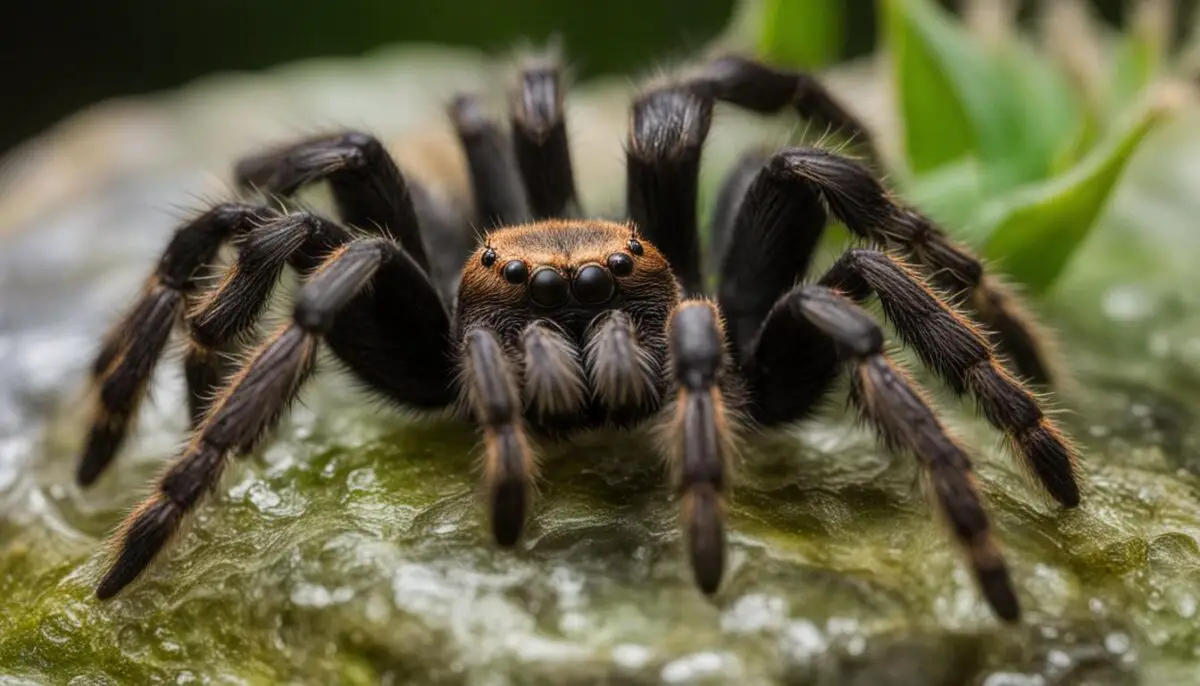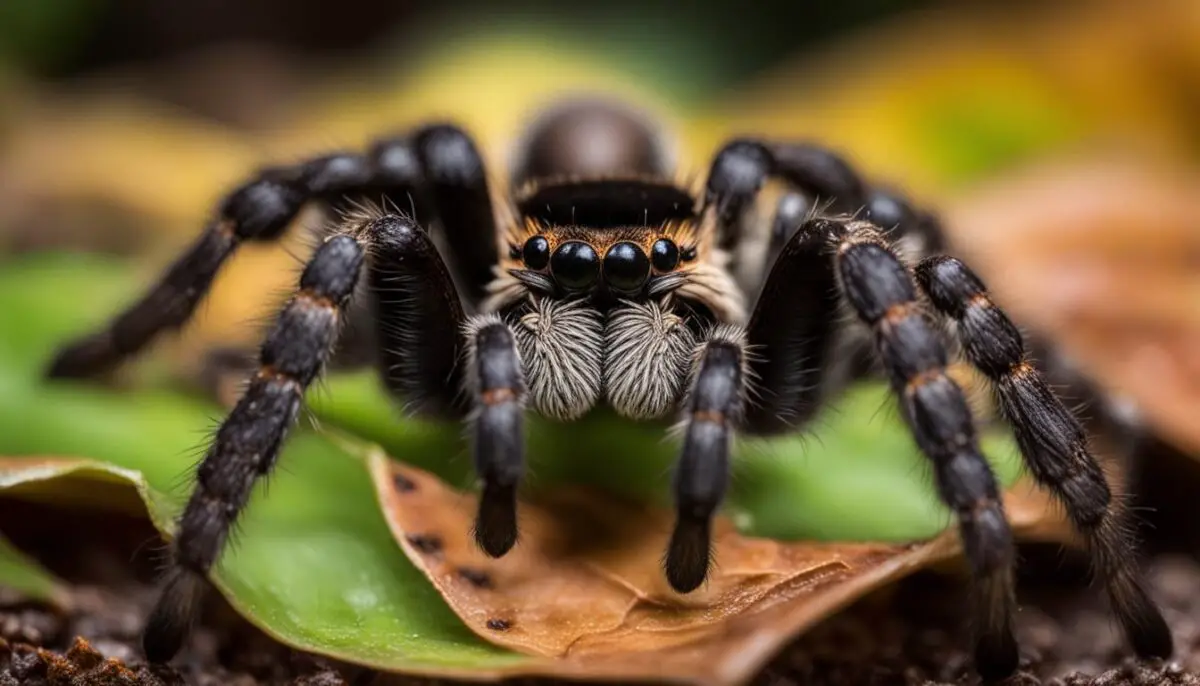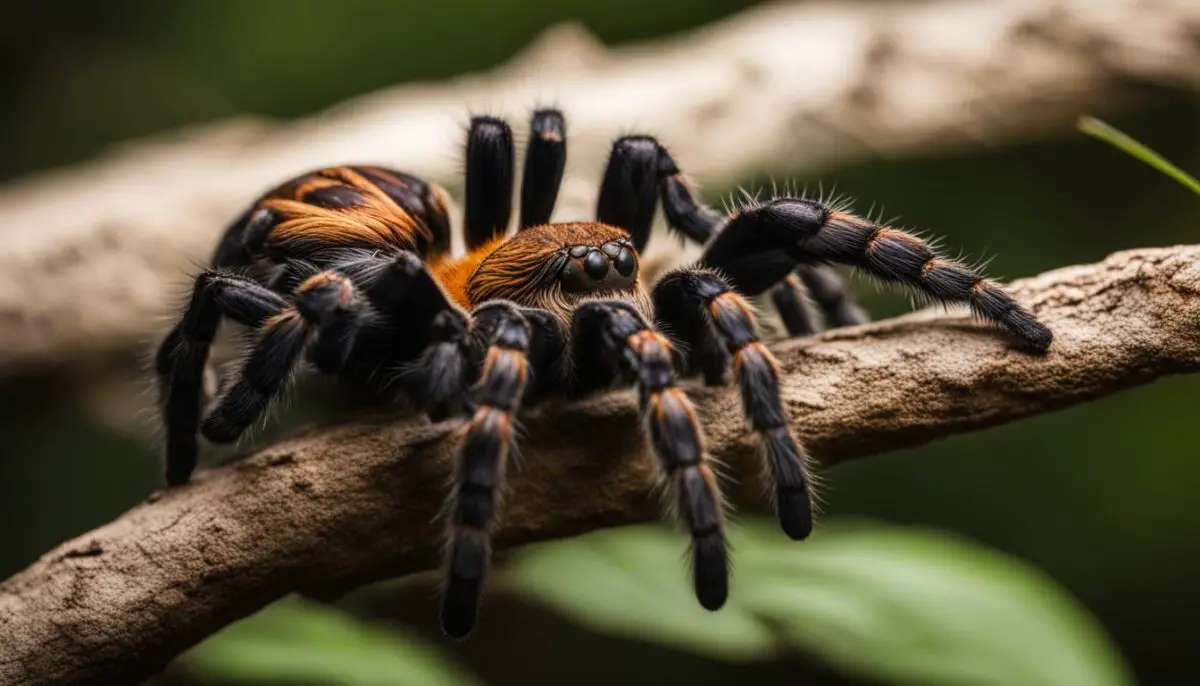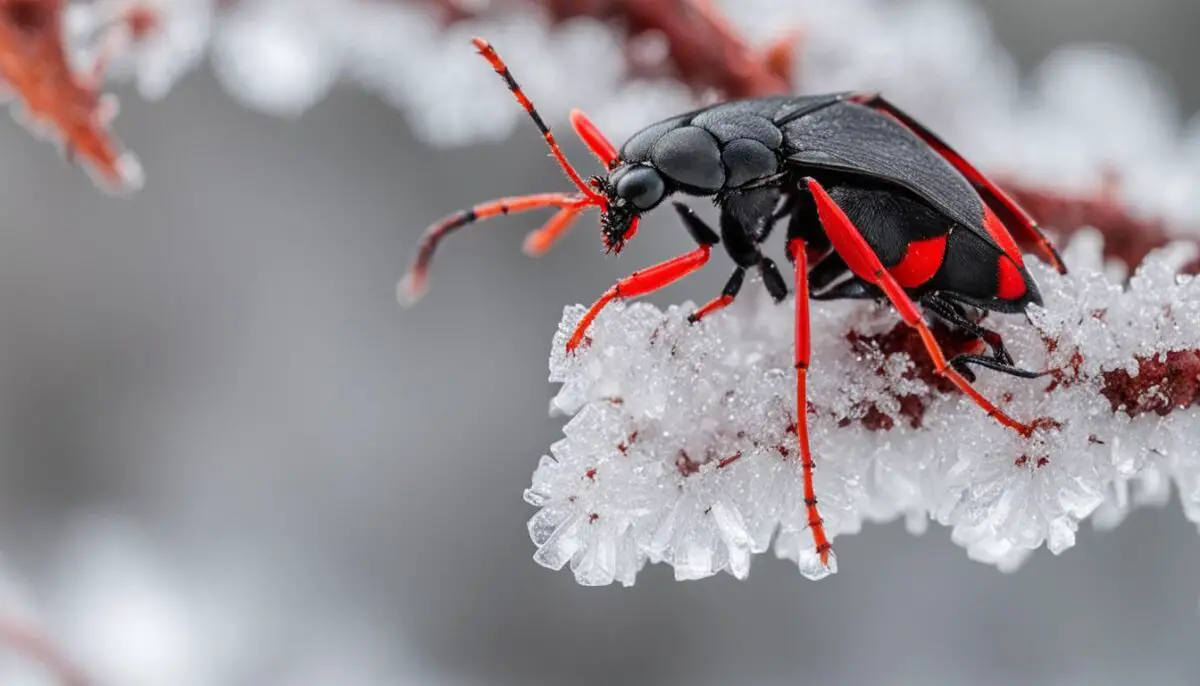Spiders, including tarantulas, are fascinating creatures with unique survival strategies. While they primarily obtain moisture from their prey, tarantulas have developed mechanisms to drink water directly when necessary. They can capture small puddles after rainfall or gather dew from foliage. Understanding the water drinking habits of tarantulas sheds light on their adaptability and survival in different environments.
Water plays a crucial role in the life of tarantulas, but how often do these arachnids actually drink? Let’s delve into the water consumption of tarantulas and explore their frequency of water intake. By understanding their water requirements, we can gain insights into the importance of hydration for these creatures.
Key Takeaways:
- Tarantulas have developed mechanisms to drink water directly when necessary.
- They can capture small puddles after rainfall or gather dew from foliage.
- Understanding the water drinking habits of tarantulas sheds light on their adaptability and survival in different environments.
- Water plays a crucial role in the life of tarantulas, and understanding their water consumption is essential.
- By understanding their water requirements, we can gain insights into the importance of hydration for tarantulas.
How Often Do Tarantulas Drink Water
Tarantulas’ Unique Exoskeleton and Water Conservation
Tarantulas possess a remarkable adaptation in their unique exoskeleton that aids in water conservation. Unlike most creatures that have internal organs to regulate water balance, tarantulas rely on their exoskeletons to prevent excessive water loss. The exoskeleton is composed of a waxy layer called the cuticle, which acts as a barrier, trapping moisture inside and preventing dehydration in arid conditions. how often do tarantulas drink water
This ingenious mechanism also helps tarantulas prevent excess water absorption from external sources such as rain or bodies of water. By maintaining a delicate balance, tarantulas can survive in various environments where water availability may be limited.
The Exoskeleton’s Role in Water Conservation
The tarantula exoskeleton plays a vital role in preventing water loss and ensuring the spider’s survival. The waxy cuticle effectively seals the moisture inside the spider’s body, reducing evaporation and dehydration. This adaptation enables tarantulas to thrive in arid habitats with limited freshwater sources, showcasing their remarkable adaptability. tarantula water drinking habits
Furthermore, the exoskeleton acts as a protective shield, safeguarding the tarantula’s internal organs from potential water loss. This intricate system of water conservation highlights the fascinating adaptations that spiders, including tarantulas, have evolved to survive in diverse environments.
| Methods of Water Conservation in Tarantulas | Description |
|---|---|
| Exoskeleton | The waxy cuticle in the tarantula’s exoskeleton traps and retains moisture, preventing excessive water loss. |
| Preventing Absorption | The exoskeleton acts as a barrier, preventing excess water absorption from external sources such as rain or bodies of water. |
| Adaptability | Tarantulas’ ability to survive in various environments with limited water availability showcases their adaptability. |
“The exoskeleton of tarantulas plays a critical role in their water conservation strategies. By preventing excessive water loss and limiting absorption, these spiders have adapted to thrive in diverse and often arid environments.” – Dr. Amanda Peterson, Arachnologist
Tarantula Water Drinking Habits: Absorbing Water from the Environment
Tarantulas have developed unique mechanisms to obtain water and maintain hydration levels. Besides relying on their exoskeletons to prevent excessive water loss, tarantulas can also absorb moisture directly from the environment. This adaptation enables them to replenish their hydration when freshwater sources are scarce. frequency of tarantula water intake
Tarantulas have specialized hairs on their bodies that are capable of capturing dew or rainwater. These tiny droplets accumulate on the spider’s body and are channeled towards its mouthparts for consumption. This method of water absorption allows tarantulas to survive in areas where reliable sources of water may be limited. It showcases their remarkable adaptability and resourcefulness in harsh environments. do tarantulas need frequent water
To understand tarantulas’ water-drinking habits better, let’s take a closer look at their unique ability to absorb water from the environment.

Tarantulas have specialized hairs on their bodies that can capture dew or rainwater. These tiny droplets accumulate on the spider’s body and are channeled towards its mouthparts for consumption.
Tarantula Water Absorption: How It Works
The specialized hairs on a tarantula’s body, known as “setae,” play a crucial role in water absorption. These setae have unique structures that allow them to trap and retain moisture. As dew or rainwater comes into contact with the tarantula’s body, the setae act like tiny capillary tubes, wicking the water towards the spider’s mouth. water requirements for tarantulas
Once the water droplets reach the mouthparts, the tarantula uses its specialized mouthparts, called chelicerae, to create small openings in the droplets. It then bends its fangs towards its mouth, using them like miniature straws to draw up the droplets and consume the water. how much water do tarantulas need
This efficient method of water absorption ensures that tarantulas can stay hydrated even in arid environments or areas with limited access to freshwater sources. By utilizing their natural abilities and adaptations, tarantulas have mastered the art of hydration in diverse habitats.
Tarantula Hydration: Water Drinking Habits and Prey Consumption
Hydration is essential for the survival of tarantulas, and they have developed unique methods to obtain water. Apart from absorbing moisture from the environment, tarantulas also acquire hydration through consuming their prey. This dual strategy ensures that tarantulas can maintain their water balance even in arid or water-scarce environments. tarantulas and hydration
When tarantulas catch and consume their prey, they not only extract vital nutrients but also obtain water from the prey’s body. This adaptation allows tarantulas to supplement their hydration needs, further enhancing their ability to survive and thrive. By incorporating prey consumption as a source of water, tarantulas have evolved an efficient and practical approach to meet their hydration requirements. tarantula water drinking frequency.
Table: Tarantula Water Intake through Prey Consumption
| Species | Size | Water Content of Prey | Approximate Water Intake per Prey (ml) |
|---|---|---|---|
| Aphonopelma sp. | Medium | 10% | 0.5-1 |
| Brachypelma smithi | Medium | 15% | 0.7-1.5 |
| Grammostola rosea | Large | 20% | 1.5-3 |
| Theraphosa blondi | Giant | 25% | 2-5 |
The table above provides an overview of the water intake tarantulas can obtain through prey consumption. The size of the tarantula and the water content of the prey are important factors that determine the approximate water intake. Tarantulas of different species and sizes may consume varying amounts of water per prey, allowing them to adapt to the availability of water sources in their natural habitats.
By utilizing both prey consumption and environmental water absorption, tarantulas have developed a comprehensive approach to stay hydrated. These fascinating creatures showcase their adaptability and survival strategies, making them unique and intriguing members of the arachnid world.
Tarantula Water Drinking Habits: A Look at Their Unique Mouthparts
Tarantulas have developed fascinating strategies to obtain water and maintain hydration in their environments. One of the key adaptations that facilitate this process is their specialized mouthparts, known as chelicerae. These mouthparts play a crucial role in tarantulas’ water consumption.
The chelicerae of a tarantula are located at the front of their cephalothorax and are used for multiple functions, including feeding and drinking. When a tarantula approaches a water source, it extends its chelicerae forward, ready to extract water for consumption. The tips of the chelicerae, known as fang sockets, have small openings that the tarantula uses to pierce the surface tension of the water. This action creates small droplets that the tarantula subsequently draws up using its fangs, acting as miniature straws.
This unique design of the tarantula’s mouthparts allows for efficient water consumption. By utilizing their chelicerae in this way, tarantulas have developed a specialized mechanism to drink water when necessary, ensuring their hydration and survival in diverse habitats.

Table: Tarantula Water Drinking Habits
| Water Source | Mechanism |
|---|---|
| External water sources (e.g., puddles, dew) | Absorption through specialized body hairs |
| Water captured in fangs | Drinking using chelicerae as miniature straws |
| Water obtained from prey | Consumption during feeding |
The table above highlights the various sources of water for tarantulas and the corresponding mechanisms they employ. Tarantulas’ ability to adapt and utilize different water sources underscores their incredible survival strategies in diverse environments.
Spiders and Sleep: Do Tarantulas Sleep?
Tarantulas, like other creatures, go through periods of rest and inactivity. However, it remains uncertain if their rest can be considered sleep in the same way that humans or other animals experience it. While tarantulas exhibit behaviors that resemble sleep, such as prolonged stillness, it is unclear if they enter a state of unconsciousness or experience rapid eye movement (REM) sleep like humans do. Further research is needed to understand the nature of tarantulas’ rest periods and whether they can be classified as true sleep.
Observations suggest that tarantulas have resting periods characterized by reduced muscle tension, slower reactions, and a generally inactive state. These behaviors are similar to what is seen in other animals during sleep. However, without the presence of distinct sleep stages or brain activity patterns associated with sleep, it is challenging to determine if tarantulas truly sleep in the same way that humans do.
Despite the ongoing debate, there is no doubt that tarantulas exhibit periods of rest and inactivity. Whether this rest can be classified as sleep or represents a different physiological state remains a topic of scientific inquiry. Further research will shed light on the sleep patterns and behaviors of tarantulas, providing a more comprehensive understanding of these fascinating creatures.

Some experts argue that spiders, including tarantulas, exhibit sleep-like behavior based on the following observations:
- Extended periods of stillness and inactivity
- Reduced muscle tension
- Slower reactions to stimuli
While tarantulas may display behaviors that resemble sleep, it is important to differentiate between sleep and the restful states exhibited by these fascinating creatures. Further research is needed to determine the true nature of tarantulas’ rest periods and whether they can be classified as genuine sleep.
| Characteristics | Sleep in Humans | Tarantula Resting Behavior |
|---|---|---|
| Distinct sleep stages | Yes | No known evidence |
| Brain activity patterns | Present | No known evidence |
| Rapid eye movement (REM) sleep | Present | No known evidence |
Tarantula Resting Behavior: Exploring Inactivity and Startled Responses
Tarantulas, like many other creatures, display periods of rest and inactivity. During these times, they may appear to be sleeping, exhibiting reduced muscle tension, stillness, and slower reactions. However, the nature of their rest and whether it can be considered true sleep is still a topic of debate among experts.
When tarantulas are startled, they often exhibit delayed responses, suggesting that they were in a resting state. This behavior further supports the notion that they go through periods of inactivity. While the level of sleep-like rest in tarantulas is still under investigation, their ability to display resting behaviors is evident.
To better understand the resting behavior of tarantulas, further research is needed. By studying their responses to various stimuli and observing their behavior during periods of inactivity, we can gain valuable insights into their adaptive strategies and survival mechanisms.
Key Points:
- Tarantulas display periods of rest and inactivity.
- When startled, tarantulas exhibit delayed responses, indicating a resting state.
- The level of sleep-like rest in tarantulas is still debated among experts.
- Further research is needed to understand the nature of tarantula resting behavior.

Table: Tarantula Resting Behavior
| Behavior | Description |
|---|---|
| Reduced muscle tension | Tarantulas display relaxed muscles during periods of rest. |
| Stillness | Tarantulas remain immobile for extended periods during rest. |
| Slower reactions | Tarantulas exhibit delayed responses when startled. |
| Inactivity | Tarantulas engage in minimal movement and reduced activity during rest. |
The Debate on Sleep in Spiders
The sleep patterns of spiders, including tarantulas, are a subject of ongoing debate. Sleep is a universal phenomenon among animals, but the specific characteristics and mechanisms of sleep in spiders are not fully understood. Research suggests that spiders, including tarantulas, exhibit circadian rhythms and periods of inactivity.
Some spiders may rest during the day, while others are active at night. The exact nature of their rest periods and how it compares to sleep in humans or other animals requires further investigation.
“The sleep patterns of spiders, especially tarantulas, are still not well understood. While they exhibit rest periods and inactivity, it is uncertain if their rest can be considered analogous to sleep in humans or other animals.”
Spider Sleep Patterns: Finding the Truth
Scientists are actively studying spider sleep patterns to unravel the mystery. By observing their behavior, monitoring brain activity, and conducting experiments, researchers aim to gain deeper insights into the sleep patterns of spiders. Understanding spider sleep can provide valuable information about their physiology and behavior, contributing to our overall knowledge of these fascinating creatures.
| Spider Species | Activity Period | Rest Period |
|---|---|---|
| Common House Spider | Active at night | Rests during the day |
| Brazilian Whiteknee Tarantula | Mostly active during the day | Rests intermittently throughout the day |
| Wolf Spider | Active during the day and night | Short rest periods between bursts of activity |
This ongoing scientific debate highlights the complexity of spider sleep and the importance of further research in the field. As scientists continue to explore the sleep patterns of spiders, we can look forward to new discoveries that may shed light on this intriguing aspect of arachnid behavior.
Boxelder Bugs: Close-up Winter Photography Subjects
Looking for unique subjects to capture in your winter photography? Consider the boxelder bug. These fascinating insects offer a captivating study for photographers during the winter season. With their distinctive markings and interesting behaviors, boxelder bugs can make for stunning close-up shots that showcase the beauty of nature even in colder months.
Boxelder bugs, scientifically known as Boisea trivittata, are commonly found around houses during winter. They seek shelter in crevices, making them easily accessible for indoor photography. Their vibrant red and black coloration, combined with prominent markings, creates a visually engaging subject for close-up shots.
One interesting behavior of boxelder bugs is their ability to release odorous chemicals as a defense mechanism. Capturing a photo of a boxelder bug in action, with its abdomen raised and chemicals released, can provide a unique and dynamic shot. This behavior not only makes for an intriguing photograph but also offers a glimpse into the bug’s survival strategies.

To enhance your close-up photography of boxelder bugs, focus on capturing their intricate details. Use macro photography techniques to highlight their delicate antennae, intricate patterns, and unique body structures. Experiment with different angles and lighting to bring out the best in these winter insects.
So, if you’re looking to add some variety to your winter photography portfolio, consider capturing the beauty of boxelder bugs. These close-up shots will not only showcase their unique characteristics but also provide a fresh perspective on the fascinating world of insects even in the coldest season.
The Intriguing Qualities of Boxelder Bugs
Boxelder bugs are fascinating creatures with unique characteristics and behaviors that make them intriguing subjects of study. These bugs primarily feed on boxelder and maple trees without causing significant harm, making them ecologically important in their natural habitats. However, they do have some interesting defense mechanisms to protect themselves from potential threats.
One of the notable qualities of boxelder bugs is their ability to release odorous chemicals as a defense mechanism. When they feel threatened, these bugs emit a distinctive odor, which serves as a warning to predators. This mechanism helps deter potential attackers and increases the chances of survival for the bugs. Additionally, boxelder bugs have bright red markings on their wings, which act as a visual deterrent to predators, signaling that they are not a suitable food source.
These bugs also exhibit unique behaviors that make them stand out among other insects. Unlike many insects that try to remain hidden, boxelder bugs are often seen in plain sight, especially during the winter months. They seek shelter in crevices and can be found in large numbers on buildings or any surface near their host trees. Their aggregating behavior provides an opportunity for close-up photography, allowing photographers to capture their distinctive markings and interesting behaviors in detail.
Boxelder Bug Characteristics
Here are some key characteristics of boxelder bugs:
- Size: Adult boxelder bugs typically measure around half an inch in length.
- Coloration: They have a black body with reddish-orange markings on their wings.
- Life cycle: Boxelder bugs undergo incomplete metamorphosis, meaning they go through three stages: eggs, nymphs, and adults.
- Feeding habits: These bugs primarily feed on boxelder and maple trees but can also be found on other trees and plants.
Overall, boxelder bugs are unique creatures with fascinating qualities that make them captivating subjects for close-up photography and scientific study. Their defense mechanisms and distinct characteristics shed light on their adaptability and survival strategies, providing valuable insights into the world of insects.
Conclusion
In conclusion, understanding the water drinking habits of tarantulas reveals their remarkable adaptability and survival strategies. Tarantulas have developed unique ways to obtain water, including relying on their exoskeletons to prevent dehydration and absorbing moisture from the environment through specialized hairs on their bodies. They can also acquire hydration by consuming their prey, extracting both nutrients and water.
Although the sleep patterns of tarantulas are not fully understood, they do exhibit periods of rest and inactivity, which resemble sleep-like behaviors. Tarantulas can enter a state of stillness and reduced muscle tension, possibly indicating a form of rest. Further research is needed to determine the nature and extent of their rest periods.
On the other hand, boxelder bugs offer a captivating subject for close-up photography during the winter season. Their distinctive markings and interesting behaviors, such as releasing odorous chemicals for defense, make them an intriguing study. While boxelder bugs are often considered pests, they contribute to the fascinating diversity of the insect world.
In summary, both tarantulas and boxelder bugs showcase the intriguing adaptability and survival strategies of these fascinating creatures. Whether it’s the unique water drinking habits of tarantulas or the distinctive qualities of boxelder bugs, these creatures continue to capture our curiosity and inspire further exploration.
FAQ
How often do tarantulas drink water?
Tarantulas primarily obtain moisture from their prey, but they can also capture water from small puddles after rainfall or gather dew from foliage when necessary.
How do tarantulas prevent excessive water loss?
Tarantulas rely on their exoskeletons, specifically the waxy layer called the cuticle, to trap moisture inside and prevent dehydration in arid conditions. This also prevents excess water absorption from external sources such as rain or bodies of water.
How do tarantulas absorb water from the environment?
Tarantulas have specialized hairs on their bodies that can capture dew or rainwater. These droplets accumulate and are channeled towards the tarantula’s mouthparts for consumption.
How do tarantulas obtain hydration through prey consumption?
When tarantulas catch and consume prey, they not only extract necessary nutrients but also obtain water from the prey’s body.
How do tarantulas drink water with their specialized mouthparts?
Tarantulas approach a water source, extend their mouthparts called chelicerae, pierce the surface tension of the water with their fangs, and then use their fangs like miniature straws to draw up small droplets of water.
Do tarantulas sleep?
While their sleep patterns are still debated among experts, tarantulas do exhibit periods of rest and inactivity that resemble sleep.
How do tarantulas exhibit resting behavior?
Tarantulas can enter periods of rest and inactivity, during which they may appear to be sleeping. They exhibit reduced muscle tension, stillness, and slower reactions.
Do spiders sleep?
The sleep patterns of spiders, including tarantulas, are a subject of ongoing debate. Research suggests that spiders exhibit circadian rhythms and periods of inactivity, but the exact nature of their rest periods and how it compares to sleep in humans or other animals requires further investigation.
Why are boxelder bugs interesting subjects for close-up photography?
Boxelder bugs can be found in plain sight around houses during winter, and they have distinctive markings and unique behaviors, such as releasing odorous chemicals to deter predators.
What are the intriguing qualities of boxelder bugs?
Boxelder bugs feed on boxelder and maple trees, release odorous chemicals as a defense mechanism, and have bright markings to warn predators. They can survive in large numbers and exhibit unique behaviors in plain sight.


I was studying some of your articles on this site and
I believe this site is very instructive! Retain putting up.Blog money